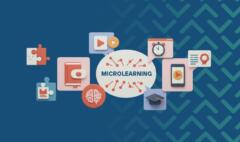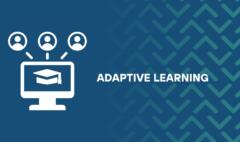The Role of Blended Learning in Developing Training Centers
- What is Blended Learning?
In a rapidly changing world, relying solely on traditional training methods is no longer practical. Training centers today need smart solutions that balance technology and hands-on experience. Here, blended learning emerges as an advanced training approach that combines the best of face to face and digital learning.
Blended learning is a training model that integrates traditional learning methods (such as in person attendance) with e-learning tools and technologies, such as recorded lectures, virtual classrooms, and online assessments. Its primary goal is to offer a more interactive, flexible, and personalized learning experience that enhances the learner’s understanding and retention of information.
In training centers, this type of learning helps reduce geographical and time barriers, enabling learners to benefit from training anytime and anywhere without sacrificing the practical aspect that sometimes requires physical presence.
What distinguishes blended learning is that it is not limited to just delivering information but focuses on building real skills through applied scenarios, collaborative projects, and live online discussions, while maintaining direct interactive engagement through face to face sessions or workshops.
In short, blended learning is the bridge linking modern technology and labor market needs, making it ideal for training centers aiming to offer modern and effective education.
- Blended Learning Models in Training Centers
When we talk about blended learning, we are not referring to a fixed template applied the same way everywhere. Instead, there are several models that vary according to the training content, target audience, and available infrastructure. Training centers can adopt one or more models based on the training program.
– Synchronous and Asynchronous Models
- Synchronous: Includes live online lectures where trainers and trainees interact in real time, even if they are not in the same location.
- Asynchronous: Includes recorded materials, forums, and tasks completed on a flexible schedule, giving learners full control over their learning timetable.
– Activity Based Model
This model focuses on combining e-training with practical applications carried out in training rooms or work labs, dividing the course into theoretical units and practical sessions delivered in person.
– Content Based Model
Often used in technical or vocational training, where educational content is delivered electronically, while face to face sessions are dedicated to discussions, questions, and applying concepts in real world practice.
These models provide training centers with the flexibility to design programs tailored to learners’ needs, allowing personalized learning experiences suitable for each individual’s capabilities, making education fairer and more effective.
- Main Benefits of Implementing Blended Learning in Training Environments
Blended learning offers many fundamental benefits that make it an ideal choice for training centers, especially those targeting diverse groups of learners in terms of age, experience, or academic background.
– Flexibility of Time and Place
One of the most notable benefits is flexibility. Learners are no longer bound to a specific time or place. They can learn from home, office, or even while traveling, which increases completion rates and overall satisfaction.
– Improved Comprehension and Understanding
Combining face to face explanations with interactive technologies enhances deep understanding of the material. Visuals, simulations, and interactive exercises stimulate the brain and help consolidate knowledge.
– Providing a Personalized Learning Environment
Blended learning systems allow analyzing learner data such as the number of views, test results, and interaction with activities, enabling trainers to offer personalized support and accurately target weak points.
– Reducing Operational Costs
By using blended learning, training centers can reduce the number of in person sessions, lowering costs related to venues, equipment, and travel without compromising training quality.
– Increasing Interaction and Motivation
Educational tools, instant quizzes, and interactive feedback help boost learners’ motivation and encourage continuous participation.
All these benefits make blended learning a strategic choice for any training center seeking excellence and expansion without sacrificing quality or efficiency.
- Technologies Used in Blended Learning
The success of blended learning depends not only on the concept but also on the technologies used to implement it effectively. Training centers can employ a variety of digital tools to create an interactive and integrated learning environment.
– Learning Management Systems (LMS)
Examples include Moodle, Blackboard, or TalentLMS, platforms used to upload content, organize courses, track learner progress, and conduct assessments centrally.
– Virtual Classroom Tools
Platforms like Zoom, Microsoft Teams, and Google Meet allow trainers to deliver live lectures, manage discussions, and share screens and presentations.
– Interactive Educational Videos
Videos embedded with questions, links, and exercises help increase focus and provide immediate feedback.
– Virtual Reality (VR) and Augmented Reality (AR)
Used in practical training in fields such as medicine, engineering, or occupational safety, enabling learners to simulate real work environments without risk.
– Electronic Assessment Applications
Tools like Kahoot, Quizizz, and Google Forms provide easy ways to assess learners instantly and analyze their results accurately.
Using these technologies enhances the effectiveness of blended learning and offers trainers and learners a smooth and advanced experience.
5. The Role of the Trainer in a Blended Learning Environment
In blended learning, the trainer is no longer just a knowledge transmitter but a facilitator, guide, and manager of an interactive learning environment. This shift requires new skills and roles different from traditional education.
– Content Design and Learning Experience Planning
The trainer participates in preparing electronic content, organizing sessions, and balancing face to face and digital activities.
– Data Analysis and Smart Decision Making
By tracking learners’ progress electronically, the trainer can analyze performance, identify difficulties, and provide immediate solutions or additional support when needed.
– Managing Interaction Across Multiple Channels
The trainer maintains a high level of engagement using forums, instant chats, and emails alongside in person meetings.
– Motivating Learners and Providing Feedback
Continuous follow up, immediate recognition, and constructive advice are key responsibilities to ensure a motivating and fruitful learning experience.
A successful blended learning trainer balances the technical and human aspects and skillfully uses tools to support the training journey in ways that meet learners’ expectations and achieve program goals.
- Challenges Faced by Training Centers in Implementing Blended Learning
Despite the numerous benefits offered by blended learning, training centers may face several challenges when applying this model, related to infrastructure, human readiness, and technical resources.
– Technical Challenges
Digital infrastructure is one of the most critical factors affecting the success of blended learning. Centers lacking high speed internet or strong learning management systems (LMS) will face significant difficulties in implementation. System failures and varying device quality among trainees can negatively impact the learning experience.
– Lack of Digital Expertise among Trainers
Many trainers still rely on traditional methods and find it challenging to handle digital learning tools, which weakens interaction and reduces the effectiveness of blended learning.
– Resistance to Change
Some trainees and trainers prefer traditional methods and view blended learning as an unnecessary challenge, especially in environments unaccustomed to educational innovation, requiring extra effort to shift institutional culture.
– Preparing Appropriate Content
Converting training content into a digital format requires special design and specialized human and technical resources, increasing costs and effort.
– Weak Human Interaction
Although online interaction is possible, some still feel that communication quality is lower compared to face to face meetings, especially in programs relying heavily on practical work or group discussions.
Solution?
Training trainers, providing continuous technical support, and preparing a clear gradual plan can significantly reduce these challenges and enable centers to smoothly transition to blended learning.
7. Blended Learning as a Means to Promote Lifelong Learning
One of the greatest advantages of blended learning is its effective role in fostering lifelong learning, which is a key characteristic of the modern learner, especially in an era of rapidly changing skills and jobs.
– Self Paced Learning
Blended learning allows trainees to progress according to their own abilities, reducing stress caused by keeping up with the group and encouraging true understanding of the material.
– Unlimited Learning Resources
Online, centers can provide additional content such as videos, articles, quizzes, and simulations to help learners revisit information and continuously expand their knowledge.
– Enhancing Learner Autonomy
Blended learning relies on an active role for the learner in research, analysis, and problem solving, boosting their confidence and motivating them to continue learning even after the training program ends.
– Long Term Interactive Support
Trainees can continue communicating with trainers or accessing training content long after the program ends, creating an ongoing and open learning platform.
– Linking Learning to Professional Development
Blended learning helps connect what the trainee learns with their career development through self assessment models and individual development plans, motivating continuous improvement.
Thus, blended learning becomes a strategic tool to create learners who never stop learning and constantly seek to improve their skills and develop themselves.
8. The Role of Blended Learning in Improving Training Quality in Centers
Improving training quality is no longer measured only by attendance or certificates issued, but by the training’s impact on professional reality. Here, blended learning emerges as a true tool for comprehensive quality enhancement.
– Performance Monitoring and Results Analysis
E-learning systems enable centers to accurately track each trainee’s performance through reports highlighting strengths and weaknesses, helping to continuously improve content and teaching methods.
– Collaborative Interaction
Online cooperative activities such as group projects and interactive discussions increase learner engagement and enhance practical learning, which is difficult to achieve in traditional education.
– Reducing Dropout Rates
Flexibility in time and place, along with easy access to content, helps increase completion rates and reduce dropouts, an important indicator of program quality.
– Continuous Content Development
The ease of updating digital content allows training centers to provide current and continuously updated information, increasing training quality and its relevance to market needs.
– Enhancing Learner Satisfaction
A personalized and interactive learning experience boosts learner satisfaction, positively affecting the center’s reputation and client trust.
Therefore, blended learning is not just a training method but an integrated system to improve quality and elevate the overall standard of vocational education.
9. Implementing Blended Learning During Crises and Emergencies
Crises, such as the COVID-19 pandemic, revealed the importance of blended learning as a means to continue education in the toughest conditions. Training centers that adopted this approach were the most adaptable and continued to deliver their programs without interruption.
– Learning Model During the Pandemic
During the pandemic, hundreds of training centers switched to remote learning. Thanks to blended learning, they were able to provide effective training including lectures, assessments, and practical projects.
– Maintaining Educational Continuity
Blended learning enabled centers to implement their programs without delay by converting workshops into virtual sessions and providing alternatives for practical training via videos or virtual reality.
– Efficient Crisis Management
Using learning management systems, centers were able to monitor trainees, measure progress, and offer necessary support without physical presence.
– Future Readiness
Blended learning today is an investment in future flexibility, enabling centers to adapt to any emergency without compromising education quality.
Centers that improved their digital infrastructure during crises are now better prepared for the future and more capable of responding to market changes or emergency conditions.
- Effective Strategies for Adopting Blended Learning in Training Centers
To successfully implement blended learning, training centers need a clear strategic plan with integrated steps ensuring gradual and effective transformation.
– Training Needs Analysis
Before implementation, study the nature of programs, trainee profiles, and available resources to determine the most suitable blended learning model.
– Preparing Technical Infrastructure
Choosing an appropriate learning management system, providing technical support, and training technical staff and trainers to handle the platform are essential.
– Trainer Training and Qualification
Organize workshops to teach trainers how to design digital content, manage virtual classrooms, and encourage remote interaction.
– Developing Customized Interactive Content
Convert content into videos, interactive slides, electronic tests, and short lessons suited for e-learning environments.
– Pilot Implementation
Apply the program on a limited batch, evaluate the experience, and adjust shortcomings before full scale rollout.
– Continuous Evaluation
Collect feedback from trainees and trainers and analyze results periodically to ensure ongoing improvement and program development.
With these steps, training centers can transition to a modern, sustainable educational model that keeps pace with developments and meets trainee aspirations.
11. Blended Learning in Training Centers: Successful Real World Experiences
Many field experiences in training centers show that blended learning has changed the game. While some institutions struggled to continue, centers that adopted this model achieved tangible results in achievement, engagement, and actual skills transfer.
– Integrating Technical Training with Virtual Reality
A successful example is technical training centers that adopted virtual reality techniques for industrial maintenance training, allowing trainees to simulate faults without risk. This model enhanced procedure understanding and improved trainees’ readiness for real work.
– Soft Skills Development Programs via Blended Learning
Some centers implemented programs to develop communication, leadership, and teamwork skills through interactive platforms that included online group tasks and live discussions. Results showed notable improvements in trainees’ confidence and skills.
– Improving Trainee Satisfaction Levels
Surveys in training centers using blended learning indicated that over 85% of trainees preferred blended learning over pure traditional methods due to its flexibility, clarity of goals, and easy access to content.
– Increasing Center Efficiency and Reducing Costs
Multiple centers reported cutting operational costs by 40% by reducing face to face sessions and leveraging digital content over the long term.
These experiences confirm that blended learning is not just a trend but a sustainable, scalable solution meeting modern learner needs and redefining training efficiency in institutions.
- The Relationship Between Blended Learning and the Quality of Vocational Training Outcomes
It’s essential to emphasize that the success of any training program is not measured solely by its content, but by its practical outcomes and impact on the trainee’s professional reality. In this regard, blended learning clearly stands out.
– Enhancing Employability
Trainees in a blended learning environment tend to acquire skills that are more aligned with the needs of the modern job market, such as digital tool usage, remote communication, and teamwork in diverse settings.
– Better Practical Application
Blended learning enables the transformation of theoretical content into interactive practical experiences. Instead of just explaining concepts, real projects can be conducted online, including practical simulations that reinforce understanding.
– More Accurate Performance Evaluation
With data analytics provided by digital platforms, training centers can deliver objective and detailed assessments of each trainee’s performance, rather than relying solely on final exams that may not reflect actual capabilities.
– Developing 21st Century Skills
Trainees engaged in blended learning gain critical skills such as critical thinking, time management, and self directed learning, making them better prepared for success in interdisciplinary careers.
This strong connection between blended learning and improved training outcomes makes it the ideal choice for training centers aiming to deliver real value to both learners and the job market.
- The Future of Blended Learning in Light of Global Digital Transformation
With the rapid acceleration of digital transformation, blended learning is no longer optional; it has become a strategic necessity for any training institution seeking to stay competitive and relevant.
– Artificial Intelligence and Personalization
Smart learning systems are increasingly using AI to analyze trainee performance and offer personalized learning paths, thereby boosting training effectiveness and speeding up the learning process.
– Augmented and Virtual Reality
In the coming years, training centers will rely more on AR and VR technologies not just in technical fields, but also for soft skills such as negotiation and team management.
– Multi Dimensional Learning Platforms
There will be increased integration between learning platforms, social networks, and administrative tools, creating a unified and seamless learning experience.
– On Demand Training
Institutions will be able to deliver tailor made training programs instantly based on actual job requirements, reducing waste and increasing productivity.
Blended learning, therefore, is not the final stage, it’s a transitional phase toward smarter, more integrated education aligned with the digital age.
14. A Comparison Between Traditional Learning and Blended Learning in Training Centers
To understand the real impact of blended learning, it’s important to compare it with traditional learning across key dimensions:
| Aspect | Traditional Learning | Blended Learning |
| Attendance | Mandatory and Intensive | Flexible and Combines In person and Online |
| Interaction Style | In person and Location bound | Varied: Live and Digital |
| Training Time | Fixed | Flexible and Customizable |
| Assessment Tools | Paper based Exams | Interactive Digital Assessment |
| Content Accessibility | Only During the Lecture | Available Anytime |
| Operational Costs | High | Lower and More Efficient |
This comparison illustrates that blended learning excels in many areas, including flexibility, efficiency, and interactivity, making it more suitable for the modern training environment.
15. Recommendations for Effectively Implementing Blended Learning in Training Centers
In light of the above, here are practical recommendations to ensure effective implementation of blended learning within training centers:
- Begin with a Clear Pilot Plan: Include one training program as a prototype.
- Invest in Trainer Development: Equip trainers with digital skills and modern teaching methods.
- Select Flexible and Scalable Learning Platforms: Support both local languages and English.
- Design Tailored Educational Content: Appropriate for the nature of trainees and the targeted field.
- Provide Continuous Technical Support: To assist trainees throughout the learning period.
- Adopt a Balanced Mix: Between theoretical and practical aspects.
- Monitor and Evaluate Performance Continuously: Using data analysis tools and smart reports.
- Encourage Interactive Learning: Through forums, group projects, and simulations.
By applying these recommendations, training centers can achieve the maximum benefit from the blended learning model, enhancing their quality and efficiency in the long term.
Conclusion
Blended learning is no longer merely an alternative method; it has become the cornerstone for any training center aiming to keep pace with development and achieve tangible results. It is a flexible, effective, and sustainable solution that enhances the trainee’s experience and makes a real difference in the quality of training and the efficiency of outcomes. The future belongs to centers that embrace change and innovate in utilizing technology.
FAQs
- Can blended learning be applied to all types of training programs?
Yes, but to varying degrees, depending on the nature of the content and the required skills. It is more suitable for theoretical programs than purely practical ones.
- What is the difference between e-learning and blended learning?
E-learning is conducted entirely online, while blended learning combines both in person and digital education.
- Is blended learning costly for training centers?
Initial costs may be slightly higher, but in the long run, it saves significantly on operations and improves outcomes.
- How does blended learning affect trainee engagement?
When implemented correctly, blended learning increases engagement through diverse technologies and activities.
- What are the essential tools for blended learning that a center should possess?
A Learning Management System (LMS), virtual classroom tools, interactive content, and an electronic assessment system.






